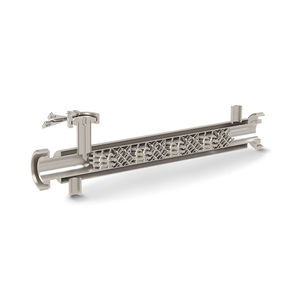
- Company
- Products
- Catalogs
- News & Trends
- Exhibitions
Static mixer PMQcontinuousfor liquidsgas





Add to favorites
Compare this product
Characteristics
- Technology
- static
- Batch/continuous
- continuous
- Product type
- for liquids, gas, gas/liquid, for crude oil, for fuel oil, for LPG
- Applications
- for the chemical industry, for the plastics industry, water treatment, for the petroleum industry, for the textile industry, for the mining industry, for the paper industry, for biological process
- Other characteristics
- stainless steel, ATEX, steel, for high-viscosity materials, explosion-proof, high-pressure, PTFE, high-temperature, low-temperature, metering
Description
PRIMIX PMQ static mixers are fully customized inline mixers that are totally adapted to the use and process flow. The static tubular mixers can be dimensioned for a large variety of volume flows, densities, viscosities and substance specific characteristics.
PMQ mixing element
- Quatro shaped mixing element design
- Performances equal to PMS
- For static mixers with a diameter of approx. 160 mm to infinity
- Suitable for basic mixing applications, liquids and gas.
Main advantages of the static mixer:
- No moving parts (motionless mixer), gaskets and shaft seals
- Low energy consumption
- Maintenance free and no risk of leakages
- Predictable homogenisation
Mixing liquids and gases during a continuous process
With the PRIMIX PMQ static tubular mixer you can create a homogeneously distributed mixing of liquids and gases in a continuous process. This takes place entirely without moving parts which means there are no extra power or mechanical elements required. For this reason static mixers are also called motionless inline mixers. The lack of moving parts makes the PRIMIX static mixers very low maintenance, and process-technically extremely safe components.
Catalogs
Related Searches
- Homogenizer for the food industry
- Liquid agitator
- Agitator for the chemical industry
- Stainless steel homogenizer
- In-line mixer
- Compact homogenizer
- Disperser homogenizer
- Blender for the plastics industry
- Gas agitator
- ATEX agitator
- Static blender
- Steel blender
- Water treatment agitator
- Explosion-proof agitator
- Helical agitator
- Agitator for the petroleum industry
- Coating technology agitator
- High-pressure homogenizer
- Metering kneader
- High-temperature agitator
*Prices are pre-tax. They exclude delivery charges and customs duties and do not include additional charges for installation or activation options. Prices are indicative only and may vary by country, with changes to the cost of raw materials and exchange rates.









